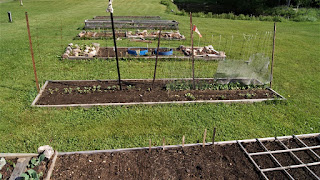We've had a couple of quite cool nights recently, but now the temperature forecast looks like we are heading into some much warmer weather. My cool weather crops, (cabbage, greens, beets, peas), have been coming along well.
There is the odd bloom on some tomato plants, and one has a small green fruit forming, although they aren't in any hurry! The peppers look pretty sad, but are recovering from the frost singeing they got at the end of May. There are some blooms on them, and on doing a closer examination of the plants this morning, this is what I found!!
This a sweet variety called Carmen, and it supposedly turns red immediately. With our short seasons, there isn't enough time before frost, to wait for the California Wonder peppers to ripen to red. We like red pepper jelly, with a little added heat of a hot pepper or two, so I am trying this variety this year.
Here is a shot through my asparagus patch. It is thriving. They were all started from seed I harvested from wild patches here and there. Next year they will be big enough to cut.
When we moved up here, there were 'sort of ' windows on the back porch. They were ill-fitting squares of framed Plexiglas, on hinges, that lifted up in the summer to let the breeze in through screening. Hubby replaced them with proper windows we scored at an auction sale. (The windows were still in their factory wrapping!) This made the back porch more secure and weather-proof. We stored the old 'windows' up in the barn just in case we found a use for them.
I've been frustrated each spring when my greens finally get big enough to eat, and then everything bolts because Mother Nature turns up the heat. I had a light bulb moment, dismantled the two biggest Plexiglas windows, (one is just over 4 feet wide, so fits right over my raised bed), removed the Plexiglas, wrapped the frame in two layers of row cover fabric, stapling it on, put little legs on the frame and placed it over the 'greens' bed. So far, maybe because it has been a coolish late spring, or, hopefully because of the shade cloth, my greens are looking good and the spinach is not even hinting at bolting!
Each spring, after the gardens are in, I like to put away a few pails of any remaining compost for future reference. Hubby made me a frame covered in half-inch hardware cloth, that fits over the wheelbarrow. I shovel the finished compost onto it, push it through with the back of a spade, and end up with some fine textured black gold.
It gets sprinkled along the rows of the little seedlings, and the courser stuff gets spread along the bean and onion rows. It is a little top dressing of nourishment for them.
 |
| Baby carrots |
Next spring, I will have some nice compost to mix in with the potting soil when my spring seedlings are ready to have their pots up-sized.






























